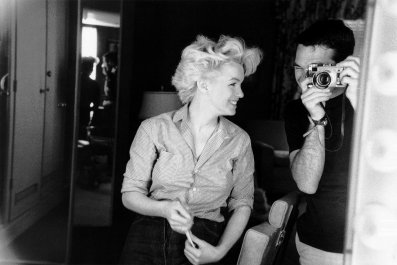For years, Lisa Bonchek Adams has been documenting her experience living with incurable, stage 4 breast cancer. She shared very publicly, first on Facebook, then on her personal blog, and ultimately, on Twitter, always receiving wholehearted support, until recently, when editorials appeared in both The Guardian and The New York Times criticizing Adams for her use of social media as a "kind of self-medication." What followed was a full-throttled media frenzy, with every publication rushing to take sides.
The hysteria is indicative of how social media has begun to make visible many of those troubling things long kept hidden: Cancer, terminal illness and death itself are being reframed by the new modes of communication.
Nowhere is this more obvious than in the mourning process, which has, for many, moved out of the quiet shadows of the bedroom and hushed congregation of nearest and dearest, to the explosively large world of social media. Twitter streams are the new eulogy; Facebook profiles are the memorial sites. When Nora Ephron passed away in 2012, her Facebook page became a meeting place for people she had touched with her work and life. It's still active to this day: Fans post quotes on Ephron's wall, and messages are sent out by "Ephron" (her publisher).
It's a weird new world, where an afterlife is eternal and in the present. But since everything else happens on Facebook, why wouldn't it be the place where people go to mourn?
Almost everyone is familiar with the five-step grieving process described by Elisabeth Kübler-Ross in her 1969 book, "On Death and Dying:" denial and isolation, anger, bargaining, depression and, finally, acceptance. The first four steps, quite clearly, are not much fun - they are the things you have to go through in order to reach a point where you can live with your loss. And in the old days, it was easy to become mired in step one; it required your initiative to reach out to others. But now, with Twitter, Facebook and Tumblr always at hand, it's nearly impossible to isolate yourself.
Maybe that's a good thing. When the "Selfies at Funerals" Tumblr, with its images of apparently self-absorbed teens preening for their iPhones while at memorial services, went viral this past year it seemed to validate the claims made by University of Michigan study that our inability to tear ourselves away from social media reflects and amplifies the growing narcissistic quality of contemporary culture. But maybe that criticism reflects more a generational divide than a character flaw. Adults who have experienced loss may see teens taking photos of themselves on their way to a funeral and tagging them #sadday and think, Disrespectful twits! But what teen knows how to deal with death? It's not such a stretch to imagine that this was the best way they knew to reach out and share with their friends. (Although it might be a little harder to cut President Barack Obama the same slack.)
"People want to feel like they are part of something," Tamara McClintock Greenberg, a professor of psychiatry at the University of California, San Francisco, told Newsweek. "Facebook allows people to find their network of people who are going to be really supportive."
Ben Nunnery, a 34-year-old Kentucky native whose wife Ali passed away in 2011 from lung cancer, learned that oversharing can sometimes lead to healing. Before Ali died, the couple took pictures together in their first house; after she passed, Ben re-created the photographs with his 3-year-old daughter, Olivia, standing in for Ali. He shared the images online for his entire social network, and got back an avalanche of support. Nunnery never expected the photos to make such an impact, but he is grateful.
"I think that [social media] allows people to connect easier and...that it not only gives us a platform to share our grief, which I think helps other people, but...it helps other people support the grief," Nunnery told Newsweek.
There are some things to consider though, before you mourn on SnapChat. While it may feel like you're getting tons of support by exposing yourself on social media, you may face criticism from strangers and, worse, rejection from friends and family. The public display of grief and emotion comes with risks.
"People you might really want to hear from might get anxious and not contact you; maybe the distance [with your friends] in social media will make it harder to cope," said McClintock Greenberg. "It's complicated." Of course, that's not necessarily different from any other part of life, where some step up and provide excellent support in times of need, while others run from any mention of death and grieving. The world of social media just amplifies both: more support, but more disappointment, too."
There's also the danger that new technologies might foster denial and make it harder to let go. In 2009, after users complained of seeing "suggested friends" from people who had passed away, Facebook began memorializing users who had died, deactivating their profiles and creating "memorials" at the request of loved ones. Memorialized profiles don't go away - they live in perpetuity (or at least as long as Facebook lasts) and give friends and family members the opportunity to look back on old posts, Facebook messages and pictures.
That's the kind of thing that can facilitate healing, but it, too, can go too far. An app launched last year called LivesOn, for example, offers the promise that "when your heart stops beating, you'll keep tweeting." Here's how it works: You give it full access to read through everything you've ever said online, and it creates a "virtual continuation" of your personality after you die, mimicking you.
It's a weird thing, the Internet, both transient and permanent. It's a place where 140 characters (#RIP) can count for meaningful sentiment and where funeral selfies are posted by 14-year-olds who can't conceive of a year past 2015, but it's also a place where memorial services take on a tone of indefiniteness and death can extend both forward and backward. Ultimately, just like IRL, grieving online is often complicated, contradictory and very personal - but most people grieving through social media are using it to reach out more than they are to withdraw. Whether it is sharing in someone's joy or sadness, feeling connected is a part of the human experience. Technology is making that easier.

























